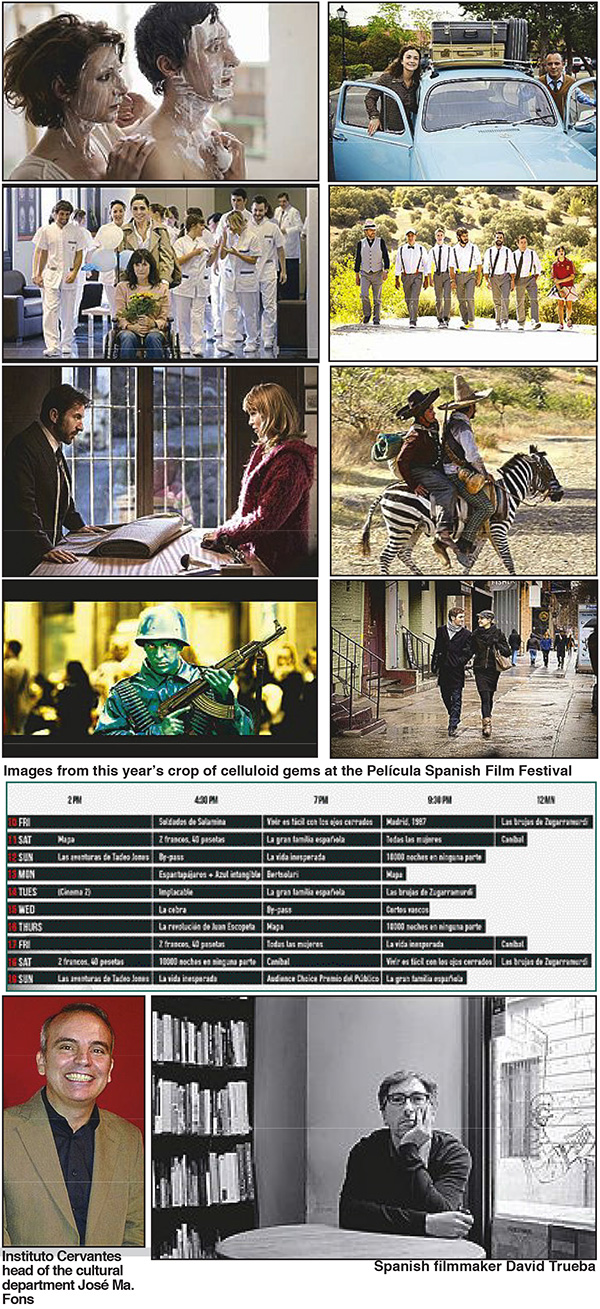‘Above us only sky’: Spanish films soar to greater heights in this year’s Película
It must’ve been quite a road trip: a professor setting off on an adventure of sorts to meet a Beatle, one incandescent day during the Sixties.
Let me take you down…
See, in Spanish filmmaker David Trueba’s 2013 film titled Vivir es fácil con los ojos cerrados (Living is Easy with Eyes Closed), this particular Beatle, arguably the most-loved, is John Lennon, shooting a movie in southern Spain, and his Spanish fan goes on the road to find him under marmalade skies. Epiphanies ensue.
“It is based on a true incident in the Sixties,” explains Instituto Cervantes head of the cultural department José Ma. Fons. “This man, who wanted to meet his idol, is teaching English to kids. (In Spain, during those days) the long-playing (LP) records seldom came with lyrics. So, he wanted to meet Lennon, let him clarify things, and tell him, ‘Hey, from now on please put the lyrics (laughs).’”
The movie draws its title from The Beatles’ Strawberry Fields Forever, and Lennon started writing that song in Almería during the filming of Richard Lester’s How I Won the War in ’66. And the essence of Trueba’s film is not the Ithaca of it all or the destination, but the journey in itself. The meandering verses, so to speak.
Fons says that along the way, the protagonist meets two young hitchhikers and their lives and stories become intertwined.

David Trueba’s film about finding Lennon is one of the centerpieces of this year’s Película-Pelikula Spanish Film Festival, which runs from Oct. 9 to 19 at the Greenbelt 3 Cinemas. Presented by Instituto Cervantes, the Embassy of Spain-AECID, the Film Development Council of the Philippines (FDCP), Greenbelt and Ayala Cinemas, the 2014 edition of the Spanish Film Festival will screen 19 films and five short films — the best and brightest of contemporary Spanish cinema.
On Oct. 10, at 7 p.m., Trueba will present his movie Vivir es fácil con los ojos cerrados, and will have an open forum after the screening. Trueba was the biggest winner at the latest Goya Awards, bagging six major prizes — Best Film and Best Director among them. The film is the Spanish entry for the upcoming Oscars.
“Trueba has two more movies in the festival — Soldados de Salamina and Madrid, 1987. (The latter) is a movie that I like very much. It’s about an old writer and a young girl, a student of journalism. Somehow, they get trapped for a whole weekend in a toilet. A beautiful film, I love the dialogue. Not everyone shares my opinion, though (laughs).”
The rest of the films take on genres ranging from romance and comedies (La gran familia Española, By-pass, 2 francos, 40 pesetas, La vida inesperada) to documentaries (Mapa, Bertsolari, Espantapájaros), animation (Las aventuras de Tadeo Jones, La revolución de Juan Escopeta), suspense or drama (Todas las mujeres)…
When asked what are the similarities between Spanish and Filipino cinemas (as opposed to yer typical Hollywood flicks), Instituto Cervantes director Carlos Madrid says, “There is depth (in both of them). When dealing with emotional and real issues of day-by-day life of individuals, Philippine cinema has a commitment to that depth — in the same fashion that Spanish moviemaking has. That leaves space, of course, for fantasy and science fiction.”
To amplify, the Ambassador of Spain to the Philippines Luis A. Calvo Castaño draws the difference between Spanish and French cinema in terms of approaching feelings and emotions.
“The French tend to do it in a more rationalistic way; they rationalize emotions. In Spain, we don’t have that filter, we tend to be much more spontaneous. Thus, it shows in our films. But in the end, (both cinemas) revolve around the same kinds of problems, formulated in different intellectual languages.”
“The narratives (of both Spanish and Filipino cinema),” points out Film Development Council of the Philippines (FDCP) chairman Briccio Santos, “have their similarities.”
He adds, “Since we’re both Catholic countries, the values are similar as well. The passion, the family as a center — (these things are key.) Considering we were under Spain for 350 years, so that already is part of our collective genes. So by watching these films, they become really a corridor in which we Filipinos can discover ourselves.”
If Spanish films are corridors, then the Película festival is a house with long and winding passageways, lots and lots of windows for kaleidoscope eyes.
Since its conception in 2002 by Instituto Cervantes, the Spanish Film Festival has been an annual attraction at the Ayala Cinemas, bringing the best of Spanish and Latin American cinema to local audiences of Manila. Fons remembers how it all started.
“I had fewer gray hairs (laughs),” he says. “The audiences have grown through the years. We started only with five movies. Now we have 24. I’ve lost my hair along the way (laughs). It is very rewarding how the festival has grown and has become a part of the lives of Filipinos. We get calls in advance every year. People come to Manila as far as Davao just to see the festival.”
And maybe get to meet David Trueba, or maybe, just maybe, the ghost of Beatle past.
* * *
Presented by Instituto Cervantes, the Embassy of Spain, the Film Development Council of the Philippines (FDCP), Greenbelt and Ayala Cinemas, Película is made possible by Emperador Distillers, Vibal Foundation, Qatar Airways, in collaboration with the Embassy of Mexico, Instituto Etxepare, Ayala Museum, Alba’s Restaurante Español, New World Hotel and Espa-Fil.
For the schedule, line-up of films, and further information on the festival, visit www.manila.cervantes.es or www.facebook.com/InstitutoCervantesManila.



















